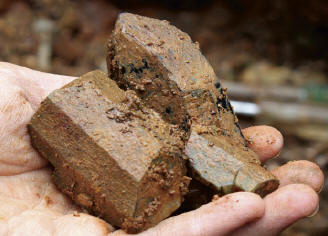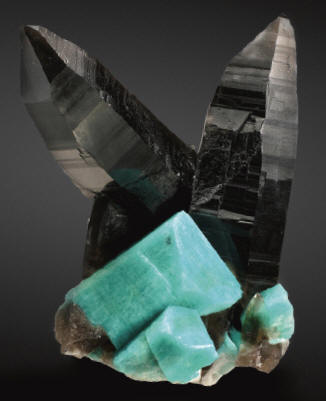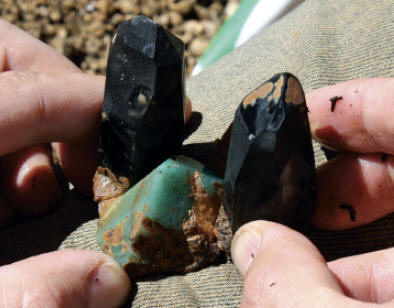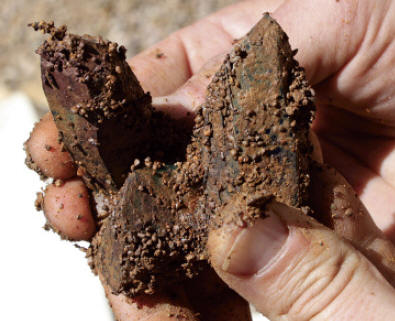Author: Joseph L. DORRIS Date: 2014-9-30 19:06:45
In our 30 years of mining, 2011 wasoff to the worst start of any season. Weknew if we did not find a great pocket, itcould be the end of our search for amazonitewith smoky quartz.

Freshly collected specimen. J. Dorris photo.
Monday morning, 13 June, thingswere going badly. We could not start theJohn Deer 992 excavator. We triedstarter fluid, new fuel filters, new air filters,pumped out fuel to drain the air,pumped out water, charged batteries,and tried again. Nothing worked. Finallygiving up, we brought the smaller JohnDeer 690 excavator into the main excavationand began work where we hadearlier discovered a pegmatite with commonmicrocline. We had been working anew dig site on the Smoky Hawk claimfor several weeks and had yet to hit anythingsignificant. With our main machine,the 992 excavator now down, wewere facing a terrible season.
My son Tim arrived and he andGeorge Quist (my machine operatorand mechanic) resumed work on themicrocline pegmatite. I headed up tothe camp to recharge some batteries andget some tools. While there, Iheard the smaller 690 excavatorstop. It meant either two things:that they had paused to collect a pocket– something good, or the excavator wasbusted as well – something the oppositeof good (It broke down two weeks laterand remained down the remainder of theseason – another major repair bill).
When I reached the excavation,I could see neither George nor Timand hollered down to see if they hadfound anything. I expected somethinglike, “Only microcline.” No color hadyet shown in this section of the excavation.
– Yeah, I got one – Tim exclaimed.
When I scrambled down to see, hewas leaning back from a small blackopening to the right of the pegmatite theyhad been working, a huge grin on hisface. George had a rare grin on his faceas well.
– I can’t reach the back – Timshoved in his arm to demonstrate.
– But does it have color? – I asked.
Tim flipped me a piece of bright blueamazonite. I stared in disbelief. Weekswithout color, digging adjacent to a commonmicrocline pegmatite, and thenhere, on an entirely different pegmatitewas the opening to a miarolitic cavity,possibly a huge pocket with color.
– Any crystals?
– Can’t tell yet. But I got somesmoky shards.
Tim handed me a chunk of glassysmoky quartz. I immediately spotted theside of a crystal face. It was well formed.
We had a pocket!
Tim was reaching in as far as hecould, trying to find an amazonite crystal.
I knew why. More times than not, thepockets we find are so badly ruptured nocrystals remain. We fill buckets with brokenamazonite and smoky quartz butnot a single intact crystal.
– Hand me the pick.

Tim holding freshly collected specimen known as “X”, above photo of the same specimen after cleaning, 12 cm. S. Neely specimen. J. Dorris and J. Callén photos.
At first I thought he might try tobreak open the opening some more – notparticularly wise if crystals could bedislodged and broken. The openingappeared to be 15 cm across by 10 cmhigh. Instead, Tim inserted the pick handleto its hilt and sat back laughing.
– It’s freaking huge.
I had to see. I shoved Tim aside andpeered in only to see an empty blackvoid.
– I need a measuring tape.
– In my truck on the side door. –George offered.
I lit out for George’s truck and thecamera.
There was still no evidence we hadquality crystals, but the size of thepocket was noteworthy, no matter whatwe found. The color was excellent andthere was smoky quartz.
Shortly, I was back. Tim had rakedout a few more amazonite shards of goodcolor – still no crystals. Some of thesmoky shards had some aragonite drippingsand iron staining, meaning therewas a well-formed void.
He inserted the tape measure.
– 60 cm – incredible. Then – 90 cm.
Unbelievable. He slid out more of thetape. It stopped at 1.16 m.
– It’s going to be near two meters.
We all recognized the wall rockswould slope downward and the pocketwould dip. It could easily go anothermeter. It was freaking huge. But did wehave any crystals?
No one wanted to remove the brokenpegmatite to find out. Like an unopenedsafe, the cavity could hold anunbelievable treasure, or it could beempty. It was nice to savor the thought ofa treasure.
Finally, we got back at it. Using the690 excavator, George took more of thetop off and pushed the working face backso we didn’t have any rocks falling on us.
I got the collecting flats. Tim hookedup the water.
– Well, this is it – I said. We beganpulling chunks of rubble away from theopening.

Same specimen when dirty and after first wash. J. Dorris photo.
Slowly it enlarged until the sunlightfell inside. A pile of breakdown greetedus. There were a few amazonite shardsand smoky quartz shards, but no wellformedcrystals, which, in a way, could be good. We hoped the ceiling plates hadseparated and settled to the floor of thepocket. If the pocket held sufficient clay,the ceiling plates would have been protectedand be in good shape. If the pockethad held little clay, the forceful rupturing after pocket formation would have damagedthe quartz crystals.






 YueGongAnBei 44051102000467
YueGongAnBei 44051102000467


 |
|